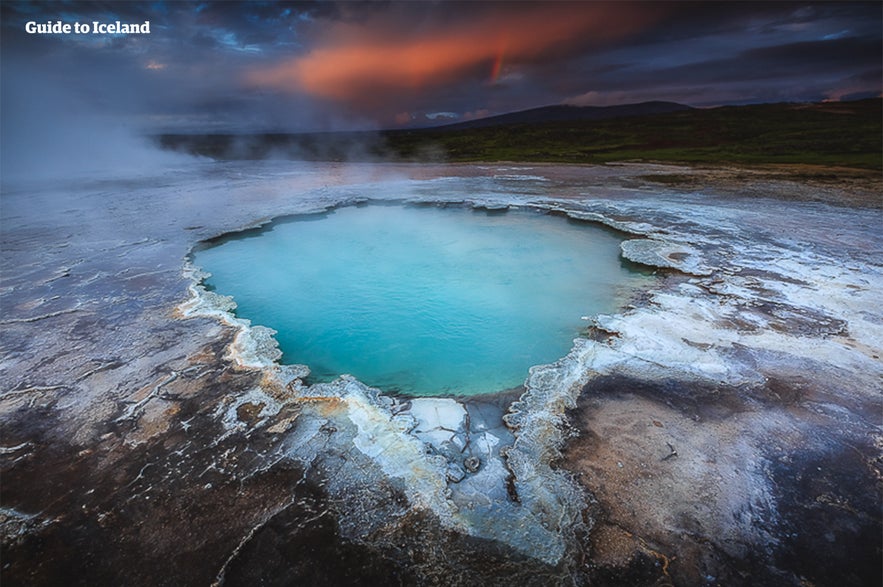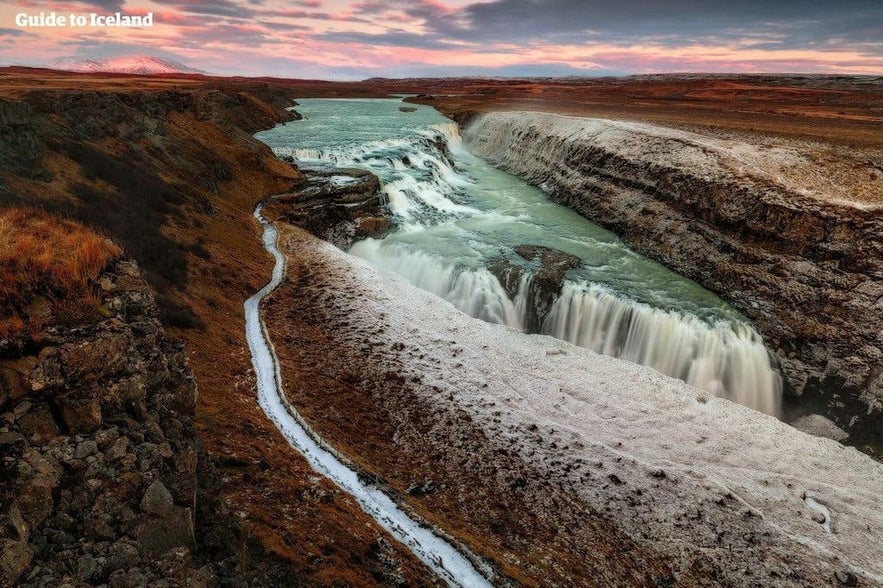Mahtava Langjökull, "Pitkä jäätikkö", on 935 neliökilometrin pinta-alallaan Islannin toiseksi suurin jäätikkö. Se on suosituin jäätikkö Islannissa maastoauto- ja moottorikelkkaretkille, ja siellä on myös mahdollista hiihtää ja vaeltaa.
Langjökull on vain noin tunnin ajomatkan päässä Reykjavíkista, joten voit vuokrata edullisen auton ja ajaa itse esimerkiksi moottorikelkkasafarille. Vaihtoehtoisesti voit kokea jäätikköseikkailun osallistumalla järjestetyille Langjökullin retkille. Jäätiköistä kiinnostuneet voivat tutustua kaikkiin Islannin jäätikköretkiin. Lue lisää saadaksesi kaiken tarvittavan tiedon Langjökull-jäätiköstä.
Miksi sisältöömme voi luottaa
Guide to Iceland on Islannin luotetuin matkailusivusto ja auttaa vuosittain miljoonia matkailijoita. Kaikki sisältömme on paikallisten asiantuntijoiden kirjoittamaa ja tarkastamaa – he tuntevat Islannin läpikotaisin. Voit luottaa siihen, että saat meiltä ajankohtaista, paikkansapitävää ja luotettavaa matkailutietoa.
Ylänköreitit
Langjökull sijaitsee Islannin ylänköseudulla, ja sen läheisyydessä kulkee kaksi pääasiallista reittiä, jotka yhdistävät Islannin pohjois- ja eteläosat.
Kaldidalurin tie kulkee Thingvellirin kansallispuistosta pohjoiseen kohti Húsafellia. Kjalvegurin tie puolestaan sijaitsee Langjökull-jäätikön itäpuolella ja Hofsjökull-jäätikön länsipuolella, alkaen etelästä lähellä kuuluisaa Gullfossin vesiputousta ja kulkien pohjoiseen kauniin Hveravellirin geotermisen alueen läpi.
Langjökullin maisemat
Langjökull on noin 50 kilometriä pitkä ja leveimmillään 20 kilometriä. Jään paksuus on suurimmillaan noin 580 metriä. Jäätikön korkein kohta sijaitsee sen pohjoisosassa, jota kutsutaan Baldjökulliksi, ja se kohoaa noin 1 450 metriä merenpinnan yläpuolelle.
Jäätikkö lepää hyaloklastiittivuoristomassiivin päällä, ja vuorten huiput ovat nähtävissä tietyissä kohdissa jäätikköä. Langjökullin alla on myös vähintään kaksi aktiivista tulivuorijärjestelmää, joiden kalderat erottuvat ilmasta käsin.
Tunnetuin näistä järjestelmistä lämmittää Hveravellirin geotermistä aluetta Baldjökullin itäpuolella. Idässä sijaitsee myös Kjalhraunin laavakenttä, joka muodostui noin 7 800 vuotta sitten.
Jäätikön luoteispuolella on toinen järjestelmä, joka on tuottanut valtavan Hallmundarhraunin laavakentän, jonka läpi Hvítá-joki virtaa kohti Gullfossin vesiputousta. Alueella sijaitsee myös Islannin pisin laavaluola, kiehtova Surtshellir.
Langjökullin lounaispuolella on Presthnúkurin laavakenttä, jonka halkeamat ulottuvat jään alle. Jäätikön eteläpuolella on Lambahraunin laavakenttä ja vielä etelämpänä Skjaldbreidarhraunin laavakenttä sekä Skjaldbreidur-kilpitulivuori.
Verrattuna muihin Islannin alueisiin, tätä aluetta pidetään suhteellisen rauhallisena, sillä siellä on tapahtunut vain 32 tulivuorenpurkausta viimeisten 10 000 vuoden aikana.
Jäätikön sisään
Langjökullin korkeimpien huippujen lähellä on ihmisen tekemä jäätunneli, joka on upea nähtävyys. Tämä geofyysikko ja presidenttiehdokas Ari Trausti Gudmundssonin suunnittelema ja rakentama tunneli tarjoaa vierailijoille mahdollisuuden tutustua jäätikön sisäpuolelle ilman, että heidän tarvitsee matkustaa Islantiin keskellä talvea vain toivoakseen näkevänsä jääluolia, joiden muodostuminen ja näkeminen on kiinni sääolosuhteista.
Vieraat kulkevat Langjökullin paksun jääpeitteen alla, ihaillen sen elävän sinistä sävyä ja saaden käsityksen jäätikön kauneudesta, muodostumisesta ja toiminnasta. Tämä on ainoa paikka maailmassa, missä se on mahdollista. "Into the Glacier" -retket yhdistetään usein muihin seikkailuaktiviteetteihin, kuten moottorikelkkailuun.
Läheiset jäätiköt
Langjökullin lähimmät muut jäätiköt ovat Eiríksjökull, joka peittää alleen Länsi-Islannin korkeimman vuoren, ja Thórisjökull. Lisäksi Hrútfellsjökull sijaitsee Langjökullin itäpuolella.
Thórisjökullin ja Geitlandsjökullin välissä on laakso nimeltä Thórisdalur. Upeiden näkymien lisäksi se on näkyvästi esillä islantilaisissa kansantarinoissa; Grettis-saagan lainsuojattoman Grettir Väkevän kerrotaan esimerkiksi asuneen täällä yhden talven.
Langjökull ja Kultainen kierros
Islannin suosituin nähtävyysreitti, Kultainen kierros, ei olisi mahdollinen ilman Langjökull-jäätikköä. Yksikään sen kolmesta ikonisesta kohteesta ei olisi nykyisessä muodossaan ilman jäätiköltä sulavaa vettä.
Gullfossin vesiputous on tästä ilmeisin esimerkki. Hvítá, putoukseen laskeva joki, on jäätikköjoki, joka virtaa suoraan Langjökullilta. Jäätikön valtavaa mittakaavaa kuvastaa sen joka sekunti alas syöksyvän sulamisveden määrä.
Geysirin kuumat lähteet puolestaan saavat vetensä maan alta. Langjökullin sulamisvesi imeytyy ympäröiville laavakentille, joiden erittäin huokoiset kivilajit johtavat sen maanalaista jokea pitkin geotermiselle alueelle. Siellä vesi purkautuu ulos luonnollisesti muodostuneista halkeamista.
Thingvellir säilyisi edelleen kansallispuistona ja Unescon maailmanperintökohteena ilman Langjökullia, sillä se sai nämä asemat maailman vanhimman yhä toimivan edustuksellisen parlamentin alkuperäisenä kokoontumispaikkana. Ilman jäätikköä maisema olisi kuitenkin merkittävästi vähemmän vaikuttava.
Kansallispuistossa on useita lähteitä, jotka ovat muodostuneet jäätikön maanalaisen sulamisveden ansiosta. Pitkän suodatusprosessin myötä Thingvellirin vedet ovat maailman kirkkaimpien luonnonvesien joukossa.
Silfra-halkeama on juuri tästä syystä Islannin paras snorklaus- ja sukelluskohde ja on jatkuvasti sijoittunut tällaisten aktiviteettien listalla maailman kymmenen parhaan joukkoon.











